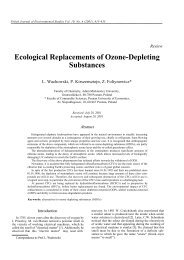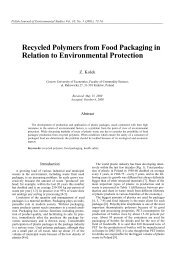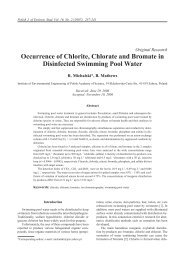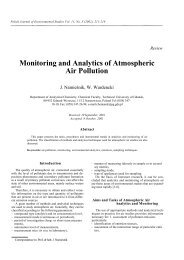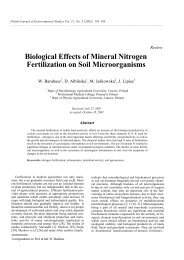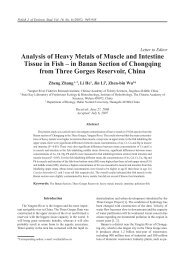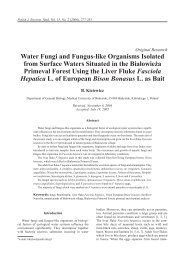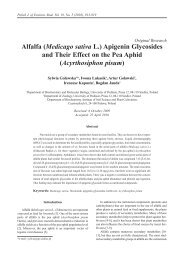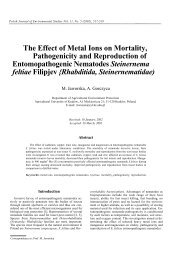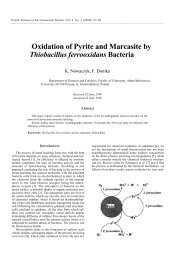Evaluation of Chelating Agents as Heavy Metals Extractants in ...
Evaluation of Chelating Agents as Heavy Metals Extractants in ...
Evaluation of Chelating Agents as Heavy Metals Extractants in ...
Create successful ePaper yourself
Turn your PDF publications into a flip-book with our unique Google optimized e-Paper software.
<strong>Evaluation</strong> <strong>of</strong> <strong>Chelat<strong>in</strong>g</strong> ... 153<br />
Extraction <strong>of</strong> Mn<br />
<strong>Chelat<strong>in</strong>g</strong> agents extracted almost similar amounts <strong>of</strong><br />
Mn (about 106.0 mg Mn/kg) represent<strong>in</strong>g only 34% <strong>of</strong> total<br />
soil Mn. In the c<strong>as</strong>e <strong>of</strong> NH 4 OAc this share averaged 20%,<br />
(Table 3 and Figs. 1, 2, 3, 4, 5). Soils used <strong>in</strong> the present<br />
work were almost neutral to moderately b<strong>as</strong>ic (except one<br />
with pH 4.9). This could partly expla<strong>in</strong> the lower efficiency<br />
<strong>of</strong> all extractants for Mn extraction, s<strong>in</strong>ce this metal e<strong>as</strong>ily<br />
forms hydroxides even at moderately neutral soil reaction<br />
[9]. It is also important to po<strong>in</strong>t out the pK values <strong>of</strong> some<br />
<strong>of</strong> these chelat<strong>in</strong>g agents (HEDTA, pK = 11.4; EGTA, pK<br />
= 13.88). The slight differences, ma<strong>in</strong>ly for extractants with<br />
chelat<strong>in</strong>g agents, may suggest that amounts <strong>of</strong> Mn reflect<br />
the e<strong>as</strong>e with which Mn is rele<strong>as</strong>ed from soils. Figure 8 illustrates<br />
only the relationship between EDTA and NH 4 OAc<br />
s<strong>in</strong>ce the rema<strong>in</strong><strong>in</strong>g chelat<strong>in</strong>g agents gave lower values <strong>of</strong><br />
the coefficient <strong>of</strong> determ<strong>in</strong>ation (R 2 < 0.70). Neither ED-<br />
TA, EGTA, NTA nor NH 4 OAc satisfactorily correlated<br />
with soil properties. The multiple regression analysis showed<br />
a relatively high <strong>in</strong>fluence <strong>of</strong> the latter ones on Mn<br />
extraction by HEDTA:<br />
Mn-HEDTA = 92.0 - 17 pH + 3.7 CEC - 0.4 Corg +<br />
+ 0.22 Clay, R 2 = 0.85 (P < 0.05) (5)<br />
On the b<strong>as</strong>is <strong>of</strong> the percentage share, extractants may be<br />
ranged <strong>as</strong> follows:<br />
EDTA (35%) = EGTA (35%) = NTA (35%) ≈<br />
HEDTA (34%) > NH 4 OAc (20%) (6)<br />
Extraction <strong>of</strong> Pb<br />
Lead <strong>in</strong> comparison with Cu, Zn and Mn is considered<br />
a naturally toxic metal. EDTA, HEDTA, and NTA extracted<br />
on average 19.0 mg Pb/kg; EGTA w<strong>as</strong> about 16.5 mg<br />
Pb/kg. As could be expected the lowest Pb level (7.0<br />
mg/kg) w<strong>as</strong> found for NH 4 OAc. In this work it w<strong>as</strong> <strong>in</strong>cluded<br />
<strong>in</strong> order to make a general evaluation <strong>in</strong> terms <strong>of</strong> its<br />
physicochemical characteristics <strong>as</strong> a metal. As listed <strong>in</strong> Table<br />
3, one may observe the follow<strong>in</strong>g percentage range <strong>of</strong><br />
chelat<strong>in</strong>g agent ability for Pb extraction.<br />
EDTA (39.5%) = HEDTA (39%) > NTA (35%) ><br />
> EGTA (31%) > NH 4 OAc (13%) (7)<br />
In terms <strong>of</strong> ability for Pb extraction, EDTA and HED-<br />
TA were found to be the most efficient (about 39% <strong>of</strong> total<br />
Pb), where<strong>as</strong> NH 4 OAc (13%) w<strong>as</strong> less so, (Table 3 and<br />
Figs. 1, 2, 3, 4, 5). Our results showed that these two<br />
chelate-enriched extractants can be permutated satisfactorily.<br />
Amounts <strong>of</strong> Pb extracted by all chelat<strong>in</strong>g agents were<br />
among them highly correlated (r > 0.90, P < 0.05). But <strong>in</strong><br />
the c<strong>as</strong>e <strong>of</strong> their relationship with the chelate-free extractant<br />
only HEDTA-NH 4 OAc gave a coefficient <strong>of</strong> determ<strong>in</strong>ation<br />
R 2 > 0.95 (Fig. 9). Amounts <strong>of</strong> Pb extracted were<br />
poorly correlated with soil physicochemical properties, irrespective<br />
<strong>of</strong> the type <strong>of</strong> extractant. A similar c<strong>as</strong>e w<strong>as</strong><br />
reported by Diatta et al. [4], who found a poor relationship<br />
between Pb extracted by HCl and HNO 3 and physicochemical<br />
properties. The multiple regression analysis established<br />
for EDTA gave the best fit, <strong>as</strong> shown below:<br />
Pb-EDTA = 95.0 - 15.0 pH - 2.0 CEC + 2. 08 Corg +<br />
+ 0.05 Clay, R 2 = 0.67 (P < 0.05) (8)<br />
Extraction methods are ma<strong>in</strong>ly b<strong>as</strong>ed on the ratio <strong>of</strong><br />
a given reagent (extractant) to a given weight <strong>of</strong> soil sample,<br />
and on the chemical feature <strong>of</strong> the extractant, i. e. with or<br />
without chelat<strong>in</strong>g agent. Some extractants commonly<br />
extract a wide range <strong>of</strong> soil elements while others are applied<br />
for a s<strong>in</strong>gle element (fosfonic complexones).<br />
Such possibilities have been earlier presented by Combs<br />
et al. [2] for extraction <strong>of</strong> Cd, Cu, and Zn (at different<br />
soil/solution). Baron [1] with ammonium acetate (20 g)<br />
+ ammonium sulphate (66 g) + acetic acid (62.5 g) + water<br />
up to 1000ml (pH 4.0) extracted B, Fe, Co, Cu, Mn, Mo<br />
and Zn (at soil/solution <strong>of</strong> 1:25). <strong>Chelat<strong>in</strong>g</strong> agents were<br />
widely applied by Norvell [15] to extract Al, Cu, Ni, Fe,<br />
Zn, Mn (at soil/extractant <strong>of</strong> 1:5).<br />
On the other hand extractions were performed for s<strong>in</strong>gle<br />
elements <strong>as</strong> well. For example Stewart and Berger [21]<br />
used 2N MgCl 2 (at soil/extractant <strong>of</strong> 1:5) to extract only<br />
Zn. In the c<strong>as</strong>e <strong>of</strong> Cu a 0.43N HN0 3 w<strong>as</strong> applied by Henkens<br />
[7] and a chelat<strong>in</strong>g agent (0.05N EDTA + NH 4 Ac; pH<br />
7.0) w<strong>as</strong> <strong>in</strong>troduced by Viro [24] both (at soil/extractant <strong>of</strong><br />
15:25) for Cu extraction.<br />
Summary<br />
On the b<strong>as</strong>is <strong>of</strong> the views presented, one h<strong>as</strong> to take <strong>in</strong>to<br />
account the fact that extraction methods vary depend<strong>in</strong>g on<br />
the conditions and aim. All these methods are partly experimental.<br />
Our results showed the importance a comparison<br />
<strong>of</strong> chelat<strong>in</strong>g agents on at le<strong>as</strong>t three parameters (i. e.:<br />
extractant concentration, pH, soil/extractant ratio, extraction<br />
time). The availability to plants <strong>of</strong> soil elements is<br />
ruled by several natural factors such <strong>as</strong> soil reaction, soil<br />
physicochemical properties, temperature, and climate. Furthermore,<br />
one chelat<strong>in</strong>g agent feature is the possibility to<br />
chelate metals <strong>in</strong> solution, avoid<strong>in</strong>g metal resorption by soil<br />
organo-m<strong>in</strong>eral particles. Another advantage <strong>of</strong> chelates<br />
over most and neutral salts is that the pH <strong>of</strong> the extract<strong>in</strong>g<br />
medium can be ma<strong>in</strong>ta<strong>in</strong>ed more closely to the normal pH<br />
<strong>of</strong> soils. Undesirable side reactions can be avoided and the<br />
extraction procedures can be made more selective for specific<br />
elements us<strong>in</strong>g complexones [19, 23]. Results <strong>of</strong> this<br />
<strong>in</strong>vestigation present a practical approach and may help<br />
somewhat <strong>in</strong> choos<strong>in</strong>g a chelat<strong>in</strong>g agent for the extraction<br />
<strong>of</strong> a given metal or group <strong>of</strong> metals. Furthermore the fractions<br />
<strong>of</strong> metals be<strong>in</strong>g extracted may be <strong>as</strong>signed <strong>as</strong> "potentially"<br />
plant available.<br />
Conclusions<br />
1. The amounts <strong>of</strong> Cu, Zn, Mn and Pb extracted by<br />
chelat<strong>in</strong>g agents were not so notably differentiated among<br />
the respective extractants.<br />
2. The percentage share <strong>of</strong> extracted Cu, Zn, Mn and Pb<br />
varied from 32 to 42% <strong>of</strong> their total, irrespective <strong>of</strong> the<br />
chelat<strong>in</strong>g agents and for chelate-free extractant NH 4 OAc<br />
from 13 to 20% for all metals.<br />
3. The best chelat<strong>in</strong>g agent for extraction <strong>of</strong> all metals<br />
w<strong>as</strong> EDTA. Copper and lead were both satisfactorily ex<br />
tracted by HEDTA <strong>as</strong> well <strong>as</strong> EDTA.



